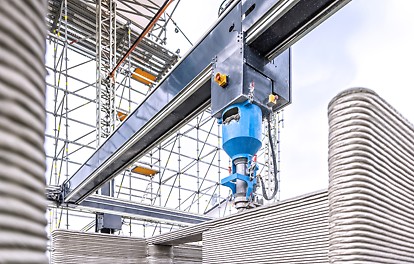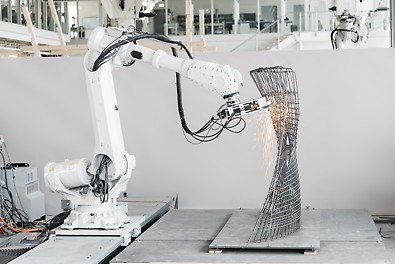
Would you like to learn more about 3D concrete printing?
Our 3D printing team will be happy to give you detailed information.

“My job is to think about how to make formwork and scaffolding superfluous. I am the disruptor on duty, so to speak, with the task of destroying PERI’s business model. Because when completely new and different processes replace classic reinforced concrete construction, we want to be the ones to bring them to the market. The question is not whether this will happen, but when. How I found myself in this job says a lot about the innovative spirit at PERI. Because, of course, there was nothing in the job description about wreaking destruction. Rather, the company was looking for someone to lead innovation management. The position was advertised internally and the application process was an idea pitch for the most innovative concept. I stood in front of the management and questioned the whole process: at PERI, innovation takes place at all levels, from the people who get their hands dirty in production and on the construction sites to the technical offices, research and development: ten thousand people are constantly thinking about how to make formwork and scaffolding better and more economical. There’s no need to add another one to that number, I said, and that I would much rather be the first to focus on what comes next. I got the job by questioning it. And I do my job by repeating that again every day.”

The downside of global urbanisation: more and more people are living in slums. According to UN figures, their number will double from one to two billion people by 2030. Together with the non-profit organisation Start Somewhere, we have therefore developed a low-cost and fire-safe construction system made of hollow concrete blocks that can be joined without mortar and by hand to form buildings with any ground plan. For us, the corresponding formwork equates to an entry-level product for a global mass market, while local people use it to produce their own building materials in small businesses, thus improving their housing situation at the same time as generating local added value.
In November 2021, we won the German Innovation Award 2021 in the category "Building & Elements" for this. You can find details on this in our press release.

MESH technology is a digital production method for reinforced concrete structures that makes it possible to produce complex or curved reinforcement cages, which were previously manufactured with elaborate manual work, through an automated prefabrication process. The 3D grid structure created in this way then serves as formwork and reinforcement at the same time and is filled with a specific concrete mix. This allows complex shapes and structures to be created cost-effectively without conventional formwork and without formwork waste.
The MESH technology is used in customised concrete structures for the production of sophisticated shapes for building construction and civil engineering as well as for the structurally optimised creation of conventional concrete structures with less material input than usual.

Building Information Modelling, i.e. fully digital building recording, optimises the construction and management of buildings of all types throughout their entire life cycle. Here, during the renovation of the sanctuary of Ulm Cathedral in Germany, it served to preserve the unique architectural monument. Thanks to digital three-dimensional as-built geometry recording and modelling, the entire sanctuary could be made accessible using the PERI UP system scaffold with an accurate fit right into the tightest corners of the Gothic vault – without causing damage or needing even a single dowel.
We use trend scouting and scenario techniques to anticipate tomorrow’s business models, technologies and products. In doing so, we boil down mega trends, industry drivers and forecast data into alternative future scenarios. Nodes of high probability emerge overlaying the possible paths towards these “futures”: robust approaches to the targeted search for disruptive technologies and products. We recognised years ago that additive manufacturing is revolutionising construction, with the result that, for example, 3D construction printing is now a successful business area for PERI, and the first printed houses in Germany came from us.

Our 3D printing team will be happy to give you detailed information.
Our support knows no borders - no matter where you are in the world. Simply select the website for your country and discover detailed information about our products, projects and contact details for our local contacts. We are always happy to assist you and look forward to helping you too.